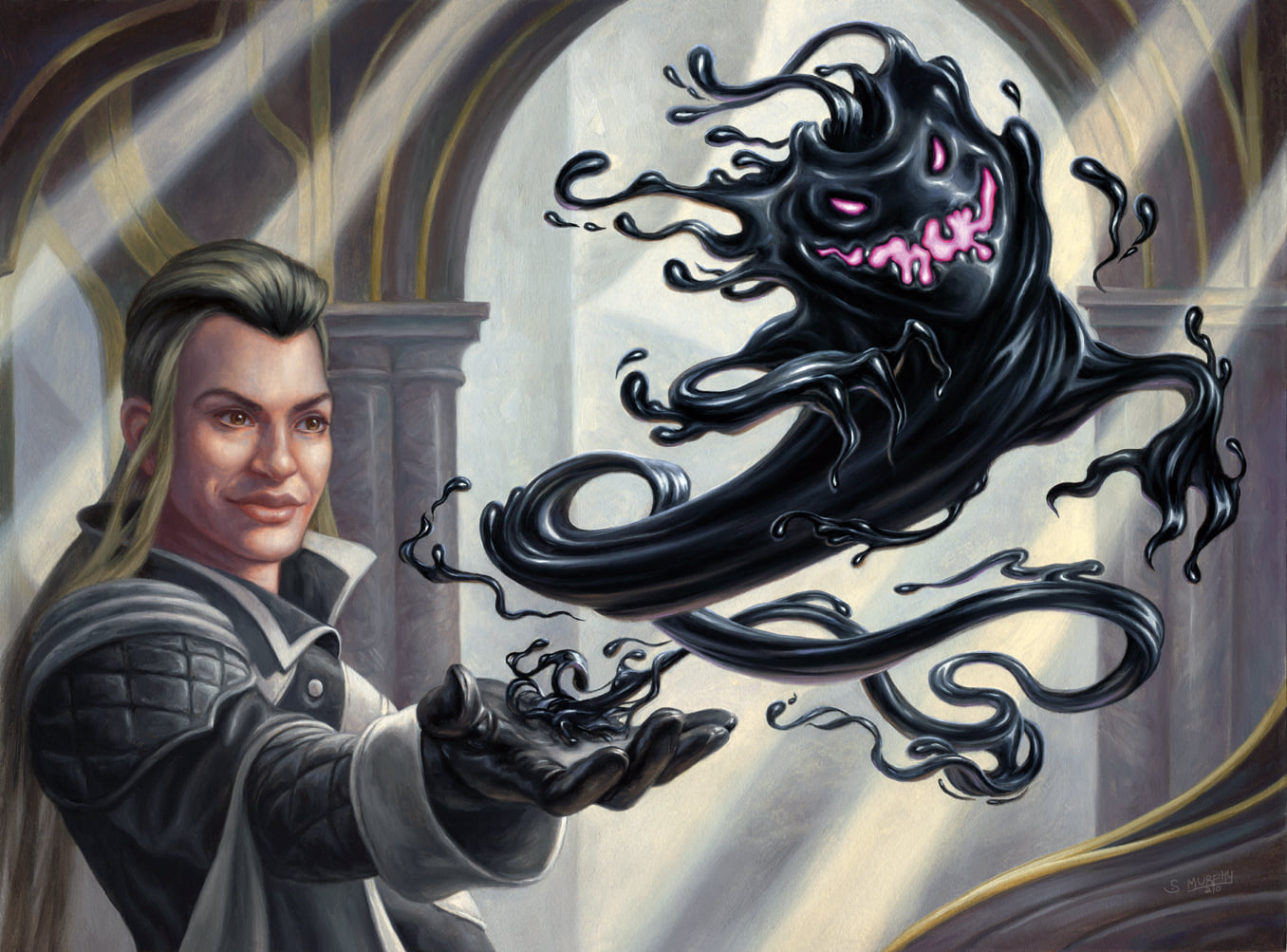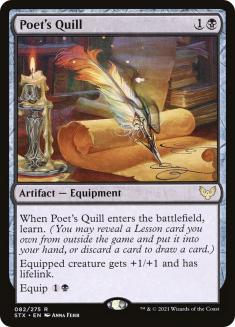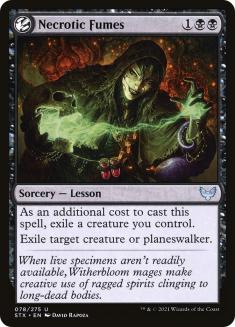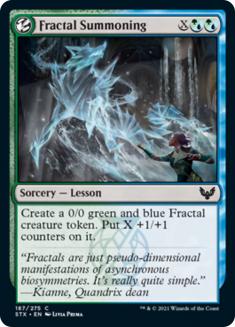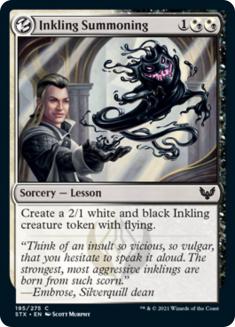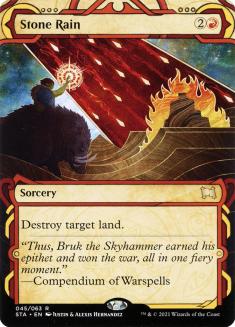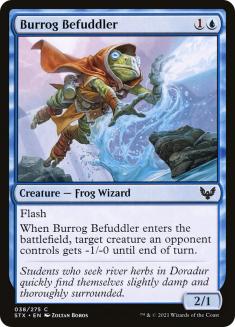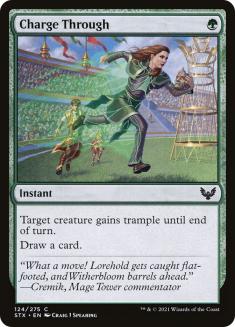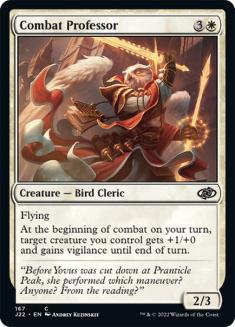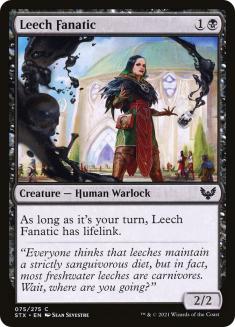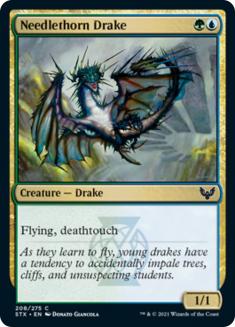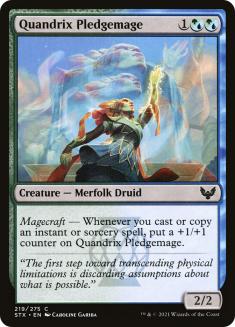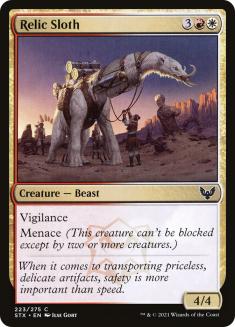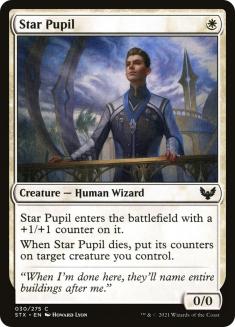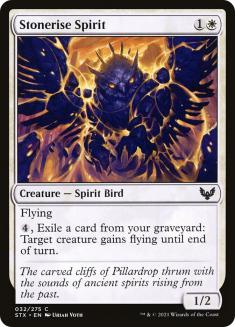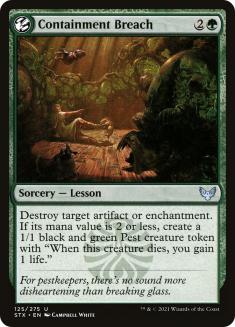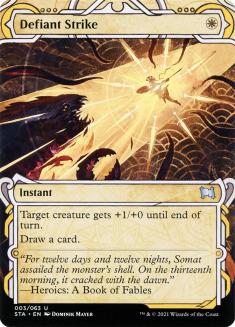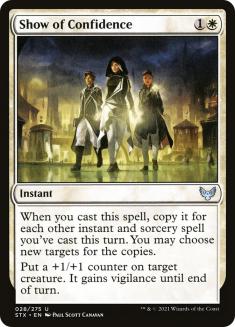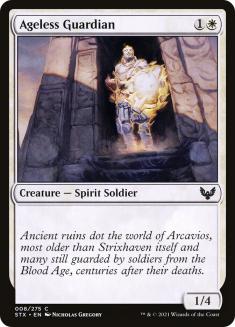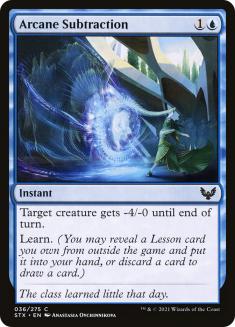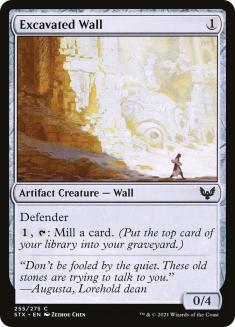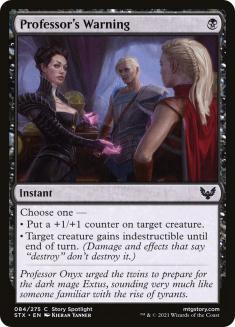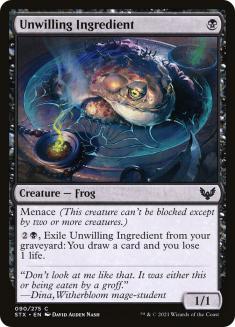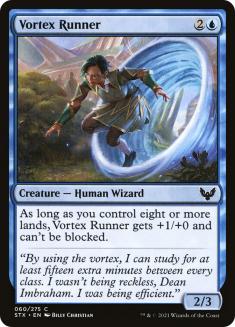Both Sam Black and I have found success with Dimir in Strixhaven Draft. Sam has labeled this archetype “Learning Curves,” which I stand by. That’s because, generally speaking, the goal of Dimir is to cast spells with learn, remove all threats the opponent casts, and win the game with Serpentine Curve. Given this plan, cards like Negate, Test of Talents, and even Snakeskin Veil can be important for protecting Serpentine Curve.
In a similar vein, Teach by Example is one of the biggest overperformers in the archetype. Copying a card with learn is so much card advantage, copying a removal spell can squash an opponent’s hopes and dreams, and, most potently, copying Serpentine Curve turns the corner sooner than anything else this format has to offer.
Two weeks ago, I began exploring Dimir on stream. It wasn’t too long before I came to the conclusions about the ways the cards interact above. But then, after thinking about it more, I began to understand the macro with respect to the metagame:
1. Dimir is the best control deck against aggro.
The main controlling decks in the format are Quandrix and Prismari. These decks have unbelievable spells to go over the top with, but their early-game is often lacking. Drafting them well requires prioritizing cards like Scurrid Colony and Prismari Pledgemage over more powerful spells to ensure the aggro matchup is accounted for.
Dimir doesn’t have this problem. Its abundant two-drops line up particularly well against aggressive decks, such as Cram Session and Hunt for Specimens. Furthermore, Dimir has access to Lash of Malice at common, which is a saving grace against aggressive decks (especially on the draw).
2. Dimir has more good commons with learn.
Black provides Cram Session, Hunt for Specimens, and Rise of Extus, which are all premium cards in this archetype. Blue provides Pop Quiz and Arcane Subtraction, which are also very good. Quandrix loses Rise of Extus and Hunt for Specimens and replaces them with Field Trip, which is not a favorable exchange, even though Field Trip is a great card. And Prismari… well… Prismari basically loses it all because the red common learn spells, First Day of Class and Enthusiastic Study, are not very good cards for controlling decks.
3. Dimir has the best interaction in the format.
Mage Hunters’ Onslaught, Lash of Malice, Rise of Extus, and Bury in Books cover all your bases. Both Quandrix and Prismari can struggle in terms of interaction because outside of exactly Bury in Books, their removal spells don’t always hit large creatures. And, unfortunately for those archetypes, Bury in Books is a premium common that not every blue drafter will be able to get. Dimir will have access to a variety of removal spells thanks to the sheer volume of possibilities.
4. Dimir has the best pivot-points for changing archetypes.
This is the unintuitive observation that took me a while to discover. Lorehold, in my opinion, is the worst archetype. Hence I would really like to be Quandrix, Prismari, Witherbloom, or Silverquill. Every single one of those archetypes overlaps a color with Dimir. Therefore, if I start a draft with blue and black cards, I’m positioned to pivot into any of the archetypes I like should a lane present itself.
As a result, even though biasing towards Dimir may sound like forcing, you actually set yourself up to be more flexible than if you were to start with cards of any other colors! If none of those archetypes present themselves with late gold cards, you can continue to draft good blue and black cards, and converge to Dimir control.
The draft below was an interesting one. I think, if you’re strongly biasing to Dimir, the picks are relatively straightforward. However, this seat did present a very open path to Silverquill, which I wasn’t able to capitalize on based on how I navigated the draft. I think it’s important to ask yourself questions such as, “Would it have been reasonable to take Card X instead of Card Y? If I had made that decision, would I have ended up in the open archetype? Would my deck be better?”
If you’re interested in learning about how to be reflective about your drafts in this manner, please refer to my article on counterfactual thinking. The next few picks, and my thoughts about them, are largely influenced by this reflective process.
Pack 1, Pick 5
The Picks So Far:
The Pack:
The Pick:
Upon reflection, I identified this pick as the junction in the draft where, if I had taken Combat Professor, I likely would have ended up with the best deck for my seat. At the time of this draft, however, white wasn’t often as open as it is now. With the information I had, and my preferences towards controlling decks at the time, I still stand by my pick of Inkling Summoning.
I think one can make a good argument for taking Combat Professor here solely because I already have a copy of Inkling Summoning. The reason I don’t think that makes a difference is that Inkling Summoning is a card I’m happy to have three copies of. In a lot of my black decks, I actively want the second copy. Furthermore, I want to lean heavily into black to keep Silverquill, Witherbloom, and Dimir open as options, so I took Inkling Summoning.
If I were to be given this option today, I would take Combat Professor. White is open more often lately, and I do think the assertive decks are better-positioned given that the durdly decks aren’t getting premium pieces as frequently.
Pack 1, Pick 6
The Picks So Far:
The Pack:
The Pick:
If I had taken Combat Professor, I would have taken Show of Confidence as a very potent card in good aggressive Silverquill decks. This would likely lock me into an archetype. However, since I didn’t, I think I would rather take Arcane Subtraction for Dimir, particularly prioritizing learn given access to four Lessons. The only question for me is whether Arcane Subtraction is good enough with respect to the other black cards in this pack, given that I could still end up Silverquill or Witherbloom.
My gut says no, again because of the learn/Lesson package. Unwilling Ingredient and Professor’s Warning are solid playables in Witherbloom and Silverquill, but they aren’t crucial cards to success with those archetypes and they aren’t very good in Dimir. If I end up Dimir, every single card with learn will matter, and missing the opportunity to take one is a mistake.
I think most people wouldn’t consider Subtraction here because they aren’t considering Dimir. They see Fractal Summoning as a mono-green card given that the rest of my cards only pair with it in Witherbloom. If that’s how you see things, I strongly recommend adjusting to allow for Dimir in your repertoire. And this pick ended up being quite important.
Below is the final Dimir deck I drafted. It had nine Lessons and ten cards with learn, so this Arcane Subtraction was absolutely fantastic. It also shows why I was so happy to take the second copy of Inkling Summoning. I know Sam Black says that he prefers Pest Summoning as the three-drop Lesson to get for defensive speed in Dimir, and I generally agree, but this particular Dimir deck was different.
I didn’t get access to any Serpentine Curves, and so my win condition was often turning the corner with evasion instead. Four copies of Vortex Runner meant I always had a good defensive play on Turn 3 that could block two-drops, which is the purpose of Pest Summoning. And, late-game, I turn the corner with multiple copies of Vortex Runner. Adding the ability to get more flyers to increase that clock, since I couldn’t turn the corner so quickly with Serpentine Curve backed by removal, was extremely important to succeeding with this deck.
This goes to show how flexible Dimir is as an archetype. The true shell is just about maximizing removal and learn. Once you do that, Serpentine Curve is the most straightforward way to end the game, but there are plenty of other potential architectures for the archetype that function perfectly well without it. The deck below is one such example.

